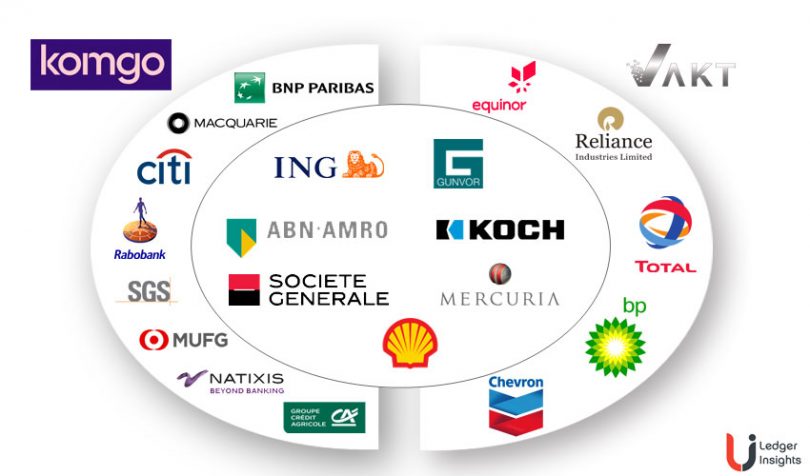On 21 December, Geneva-based komgo, the global blockchain-based trade financing platform backed by 15 of the world’s largest banking and commodity companies, processed its first live Letter of Credit, just three months after the launch announcement.
Société Générale confirmed on LinkedIn that it used the blockchain network to finance a transaction for North Sea oil with trading company Mercuria. As with several other enterprise blockchains, it’s a cautious soft launch.
Komgo, announced last September, is the latest incarnation of blockchain proofs of concept jointly run by ABN Amro, ING and Société Générale (SocGen), called Easy Trading Connect, which were first unveiled in late 2017. Its shareholders comprise ten significant banks, four oil companies and traders and certification company SGS. Komgo has seven shareholders in common with the VAKT blockchain for post-trade commodities.
To be or not to be a utility
The inclusion of energy and trading companies as shareholders differentiates komgo from the other trade finance blockchains that are all solely funded by banks. Komgo CEO Souleïma Baddi commented that “if you want to build a solution for the industry, you need to build it with the industry and not only with banks.”
With purely banks as shareholders, it’s possible to position the company as a utility. In that case, licensing fees from the blockchain platform itself are not seen as a source of revenue for the banks.
Baddi was clear that komgo is not such a utility. “[The shareholders are] happy to support us up to a certain point. So we have to become profitable at some point to be able to continue growing.”
Responding to concerns that a profit model could eventually make the platform too pricey for smaller players, Baddi, who once managed a portfolio of small and niche traders for Société Générale in Geneva, said she won’t let that happen. “If you kill them on the pricing, the platform is useless at the end of the day,” she said.
Komgo was founded last August with 15 million Swiss francs ($15 million) in funding for the first 18 months. Baddi is already working on the second round of financing needed this year. Nine of the founding shareholders are currently on the board, which will be revisited at the second funding.
Why commodities?
Why is a specialist commodities blockchain needed when there are already several trade finance consortia or joint venture blockchains such as we.trade, Marco Polo, and Voltron? Trade and commodity finance is more complex and tailor-made in comparison to mainstream trade finance, Baddi explained. To use a Letter of Credit (LC) drafted for one industry and apply it to another sector would be too risky. The energy sector is quite particular in that a Letter of Indemnity (LOI) is typically required for where the buyer or carrier is unable to produce a Bill of Lading.
Another issue is the need for standardization. “In the commodity industry every [firm] has its own contract and own LC but at the end of the day the added value is not there, and it’s too costly for the industry today,” explained Baddi. “So there’s a huge willingness to push a bit of standardization in an industry that has not changed for the past 500 years” in a bid to streamline costs.
Baddi noted that during the PoC experiments, from a bank’s perspective, transactions were five times faster. ING was one of the PoC partners, and a representative currently chairs komgo’s board. Anthony van Vliet, ING’s Global Head of Trade & Commodity Finance told Ledger Insights via email that the benefits are a reduction in costs of financing, better service to clients, and freeing up capacity to focus on growth. “Although it is too early to be conclusive about savings calculations, indications are that they will be material.”
The VAKT relationship
Another question is how komgo fits in with VAKT, the post-trade commodities blockchain. At the time of komgo’s unveiling, most of VAKT’s shareholders were also shareholders in komgo.
Baddi is intimately familiar with VAKT because she was on the board as a representative of SocGen until she resigned and moved over to komgo full-time. She explained there was a deliberate decision to exclude trade finance from VAKT.
Firstly, innovation is high risk, so separating the projects lowered the risk. The second reason related to funding and developing the network. By splitting the networks, each company can have additional sources of financing and network participants. Finally, VAKT is focused on energy, which is a massive sector on its own. Komgo intends to expand into agribusiness, metals and shipping.
Its predecessor Easy Trading Connect ran a PoC with agribusiness company Louis Dreyfus Group. Dreyfus is the “D” in the ABCCD consortium where five of the world’s largest agribusiness companies – Archer Daniels Midland, Bunge, Cargill and COFCO – plan to use blockchain and artificial intelligence to digitize shipping. The core team behind Easy Trading Connect now work for komgo.
Both VAKT and komgo use Quorum, the JP Morgan enterprise technology version of Ethereum. However, komgo is working with technology provider Consensys and VAKT, with Thoughtworks. There’s a shared directory of users and interoperability. Transactions that happen on VAKT can be sent to komgo and populate the LC directly.
What’s next?
A major value proposition of komgo is privacy and security, according to Baddi. “As a company, we do not see any transactions, any data or anything that happens on our network. So we’re bringing to the industry a secure network, for exchanging data and documents. We don’t store any data. We don’t see any data.”
Hence, the second module that komgo created is a peer-to-peer document exchange called Kite. A document hash, but not the document is stored on the chain with a timestamp. So the digital paperwork goes from one private network through the komgo network to the other private network.
One of the biggest pain points with commodities is Know Your Customer (KYC) compliance. Every year traders who may work with numerous banks have to send as many as 30 KYC documents to each bank. And apart from KYC, there are the trade documents themselves for negotiating Letters of Credit. Outside of komgo, the paperwork is usually shared by email which is inherently insecure. Now with a single button click, a trader can share all its KYC documents with all its banks. “This brings massive efficiency, massive security and additional privacy to the industry,” Baddi said.
A significant aspect of security is that the party sending paperwork is authenticated. “At the bank, when I received a warehouse certificate, I didn’t know if this was the warehouse certificate sent by the original inspection company or if it was a fake one. And fake documents arrive every day in our business,” she explained.
The next focus is to improve the LC and the auto-match function and to add Letters of Indemnity. The auto-match will report discrepancies between the documentation and the LC and will require human intervention to review differences.
Easy Trading Connect demo:
Sizing up the competition
Once komgo’s energy sector offering is more mature, it plans to target other commodity sectors, with talks already underway. One of komgo’s advantages is its location in Geneva. Apart from Switzerland’s well known corporate tax advantages, the region claims to have 40-60% of the world’s trade finance activity. Plus Geneva is home to 35% of the world oil trade, 50% of the trade in sugar and coffee, and 35% of the world’s cereals, oilseed and rice trade, according to the canton’s Directorate General for Economic Development, Research and Innovation.
When komgo extends beyond energy it will become a more direct competitor to the Voltron blockchain network, which also targets Letters of Credit and has a common shareholder in ING.
Agribusiness is a potential battleground. Komgo’s predecessor Easy Trading Connect executed the first blockchain transaction for soya beans with Louis Dreyfus Company. Voltron’s first transaction was also for soya beans with Cargill.
HSBC initiated the Voltron transaction, so we asked Joshua Kroeker, HSBC Director and Blockchain Lead for Global Commercial Banking, about the potential for competition. He commented: “We’re very interested to see how this all matures. There’s a lot of different networks that are emerging right now because there’s a lot of problems to solve.”






